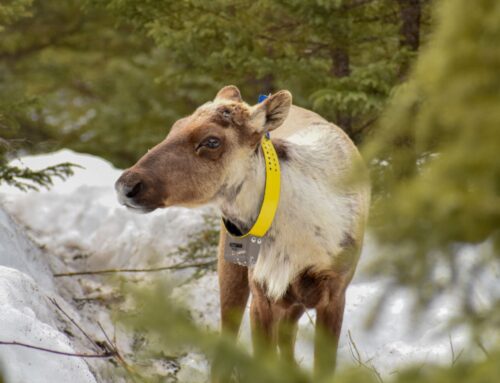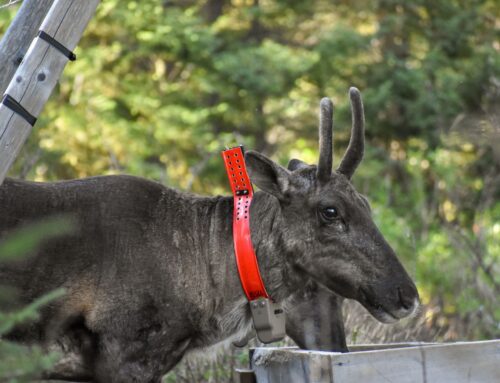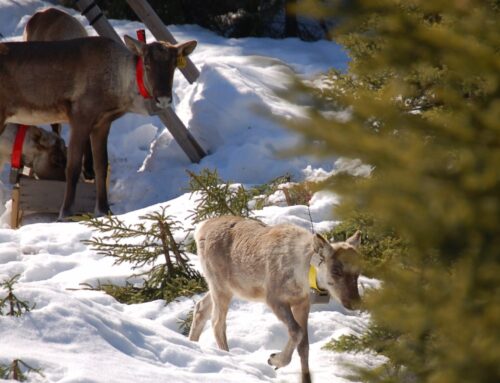Source: Le Devoir
Published on April 21, 2017
In an unprecedented move, the Quebec government has decided to capture the last caribou of the Val-d’Or herd and send them to the Saint-Félicien Zoo, Le Devoir learned. A decision that could make life easier for the forest industry in Abitibi, since the protection of the territory of this threatened species has been imposing constraints on it for several years.
The Minister of Forests, Wildlife and Parks, Luc Blanchette, was to announce Friday morning in Val-d’Or the decision to remove the 20 or so woodland caribou from their natural environment and move them to the “zoo sauvage” located in Lac-Saint-Jean.
Minister Blanchette’s office refused to answer questions from Le Devoir on Thursday. It was therefore not possible to know if the ministry had conducted a scientific study on the feasibility of the project before making its decision. Nor was it possible to obtain any comments from cabinet on the precedent set by this removal of an endangered wildlife population from its natural environment.
One thing is certain: the government’s decision is good news for the Saint-Félicien Zoo. The zoo has been home to caribou for more than 50 years. But in 2015, 19 of its 21 caribou died suddenly. The zoo had hoped to receive a new herd from Western Canada in 2016, but the project was finally aborted. Zoo management did not return Le Devoir‘s call.
However, this complex operation will sound the death knell for one of the last two isolated populations of woodland caribou in Quebec. This one and the one in Charlevoix (85 head) are indeed unique, since they are not in contact with the larger population located further north.
The Val-d’Or group is already in a critical situation. In fact, it is only a relic of the population that frequented the region before its industrial development.
Protected territory
To prevent the disappearance of this herd, the Quebec government had, over the years, put in place protection measures as part of the recovery plan for the woodland caribou, designated since 2005 as a “vulnerable species” in Quebec (it is listed as a “threatened species” on the federal list). It was thus hoped that the herd could reach at least 50 animals.
In 2009, Quebec established the Caribous-de-Val-d’Or biodiversity reserve, which covers an area of 434.2 km2 and is located southeast of the city. The objective was to provide the last caribou with an area where all industrial activities are prohibited, including logging, but also exploration and mining. However, mining claims are active around this area.
This territory essentially covers the range from spring to late fall. In winter, the animals may indeed frequent other sectors where the exploitation of the territory’s natural resources has the effect of disturbing their habitat.
Outside the biodiversity reserve, the government also introduced a forest management plan several years ago that imposes stricter rules on the forest industry in order to reduce impacts on caribou. It is true that this species, which uses vast territories, is particularly sensitive to the disturbance and destruction of its natural habitat. For example, forest roads can easily disturb areas frequented by caribou.
Caribou and jobs
In economic circles, some voices have been raised to criticize the “costs” of the woodland caribou recovery plan, including the Montreal Economic Institute (IEDM). In an analysis produced in 2015, the organization called on the government to “take into account the socio-economic impact of the Woodland Caribou Recovery Plans and ensure that costs are not disproportionate before imposing further restrictions on logging”.
The IEDM also estimated that saving each caribou could be equivalent to the sacrifice of 31 jobs and $3.8 million in revenue due to the more severe constraints imposed on the forest industry. In the 2014 election campaign, Philippe Couillard had stated that he would not sacrifice “not a single job in the forest for the caribou.”
Once back in power, the Liberals also postponed the full implementation of the 2013-2023 recovery plan for woodland caribou, mainly because of the impacts on the forest industry. In theory, this plan was supposed to reduce disturbance on part of the caribou’s territory. The final objective would be to increase the caribou population to 11,000 animals, whereas it is currently between 5,900 and 8,500.





